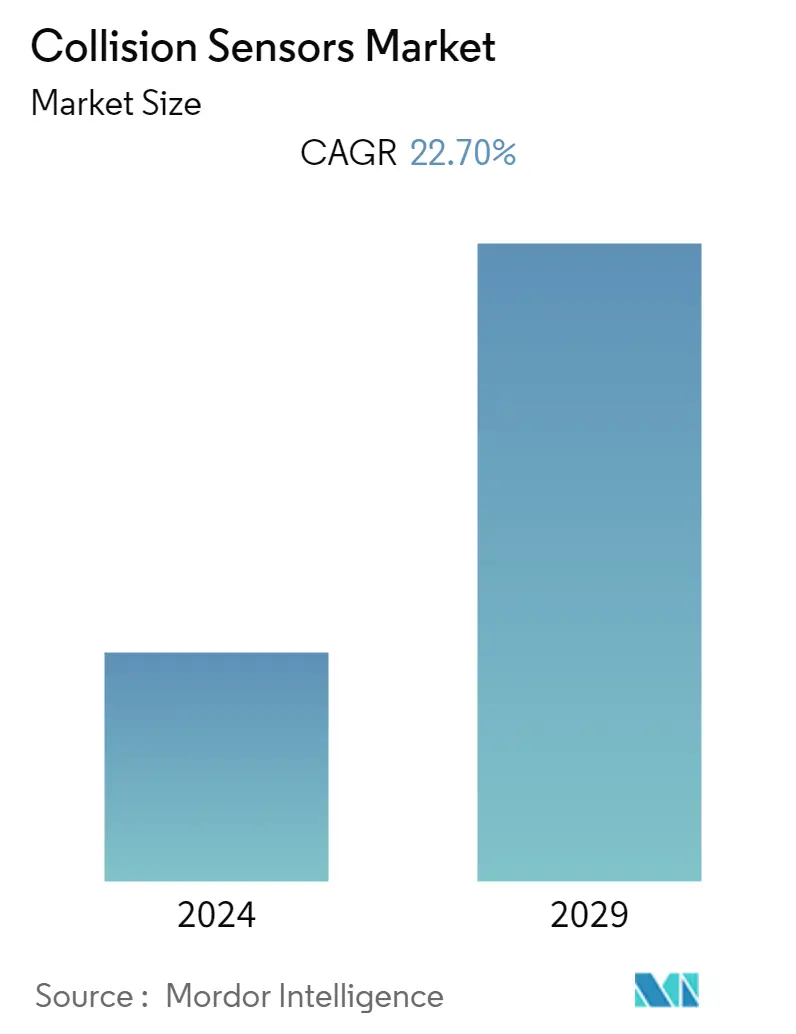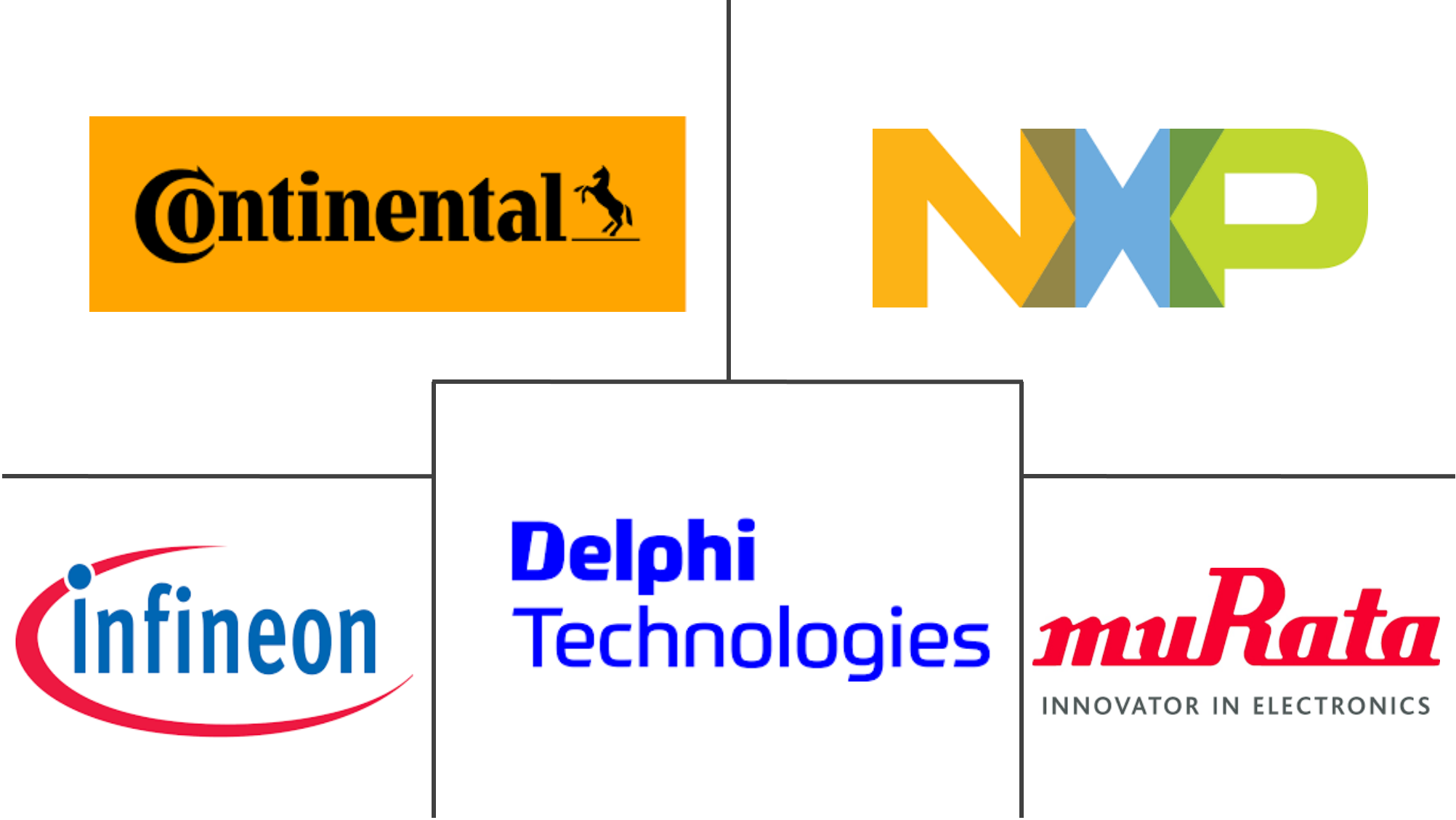Market Size of Collision Sensors Industry

| Study Period | 2019 - 2029 |
| Base Year For Estimation | 2023 |
| CAGR | 22.70 % |
| Fastest Growing Market | Asia Pacific |
| Largest Market | Asia Pacific |
| Market Concentration | Medium |
Major Players
*Disclaimer: Major Players sorted in no particular order |
Collision Sensors Market Analysis
The collision sensors market was valued at USD 6.23 billion in 2020, at a CAGR of 22.7% over the forecast period 2021 - 2026. The automobile industry is growing fast, and end-user expectation is far beyond what has been realized. The current development in the trade has been to rework the control systems of the essential functions of a vehicle (acceleration, de-acceleration, braking, and steering) performed by mechanical or hydraulic systems to more suitable, flexible and dependable electrical/electronic systems. The combination of collision sensors in the anti-collision systems in mass-market vehicles and updated safety ratings of agencies are anticipated to boost market growth over the next few years. Though, the vast cost of LiDAR-based systems and long-range radars might cause an obstacle to market growth as manufacturers of low-priced cars may abstain from placing sensors to avoid growing the overall cost of vehicles.
- New technological developments in sensors are focused on building extremely sophisticated devices and increasing their performance using several components of the vehicle. Anti-collision systems allow automotive OEMs to combine additional knowledge to achieve the goal of producing an autonomous vehicle. Developed economies are now inclined toward automated systems and driverless cars, which makes it mandatory for the inclusion of anti-collision sensors, thus fueling the growth.
- The integration of sensors in collision avoidance systems in vehicles is expected to help reduce the number of vehicle accidents due to human errors, as every year the lives of approximately 1.35 million people are cut short as a result of a road traffic crash and between 20 and 50 million more people suffer non-fatal injuries, with many incurring a disability as a result of their injury (World Health Organization, 2018).
- The limited detection limit of this device is supposed to be a principal restraining factor. Moreover, the absence of awareness concerning the technology is anticipated to restrain the market growth. The debut of these systems in vehicles has raised the complexity of vehicle consoles, the probability of system component failures, errors in system design, and unconscious driver errors. This is expected to negatively influence parking sensors' market growth.
Collision Sensors Industry Segmentation
Collision sensors are placed within a car which provides a warning to the driver if there are any dangers that lie ahead on the road. These sensors include how close the car is to other cars, how much its speed needs to be reduced when obstacles closer to the car, how close the car going off the road, and the system consists of audio warning to prompt the driver, initiates braking if the driver fails to respond to the warning.
| By Application | |
| Adaptive Cruise Control | |
| Forward Collision Warning System | |
| Blind Spot Monitor | |
| Lane Departure Warning System | |
| Parking Sensor | |
| Other Applications |
| By Technology | |
| Ultrasonic | |
| Radar | |
| Camera | |
| LiDar |
| By End-User | |
| Automobile | |
| Aerospace & Defense | |
| Maritime | |
| Rail | |
| Other End-users |
| Geography | ||||||
| ||||||
| ||||||
| ||||||
| Rest of the World |
Collision Sensors Market Size Summary
The collision sensors market is experiencing significant growth, driven by advancements in the automotive industry and the increasing demand for enhanced vehicle safety features. The shift from mechanical and hydraulic systems to more flexible and reliable electrical and electronic systems is a key factor propelling this market. The integration of collision sensors into anti-collision systems is expected to improve vehicle safety ratings and reduce accidents caused by human error. However, the high cost of technologies like LiDAR and long-range radars may hinder adoption in low-cost vehicles. Despite these challenges, the market is poised for expansion, particularly with the growing interest in autonomous vehicles and automated systems in developed economies.
The Asia Pacific region is anticipated to witness substantial growth in the collision sensors market, fueled by the rising number of vehicles in countries like India and China, along with supportive government policies and rapid urbanization. The presence of major manufacturers and the increasing focus on road safety and technological advancements in the automotive sector further contribute to this growth. The market is moderately fragmented, with numerous key players such as Continental AG, Robert Bosch GmbH, and Denso Corporation, indicating the market's potential for new entrants. Innovations in radar technology, known for its precision and broad range, are expected to dominate the market, particularly in the context of autonomous cars and Unmanned Aerial Vehicles (UAVs).
Collision Sensors Market Size - Table of Contents
-
1. MARKET DYNAMICS
-
1.1 Market Overview
-
1.2 Introduction to Market Drivers and Restraints
-
1.3 Market Drivers
-
1.3.1 Rising Awareness about Vehicle Security
-
1.3.2 Technological AdvancementS and Development in Sensors
-
1.3.3 Rising Adoption of Collision Sensors in Military and Defense Sectors
-
-
1.4 Market Restraints
-
1.4.1 Increased Price of the Technology
-
1.4.2 Less Use of These Sensors in Low Priced Car
-
-
1.5 Industry Attractiveness - Porter's Five Force Analysis
-
1.5.1 Threat of New Entrants
-
1.5.2 Bargaining Power of Buyers/Consumers
-
1.5.3 Bargaining Power of Suppliers
-
1.5.4 Threat of Substitute Products
-
1.5.5 Intensity of Competitive Rivalry
-
-
-
2. MARKET SEGMENTATION
-
2.1 By Application
-
2.1.1 Adaptive Cruise Control
-
2.1.2 Forward Collision Warning System
-
2.1.3 Blind Spot Monitor
-
2.1.4 Lane Departure Warning System
-
2.1.5 Parking Sensor
-
2.1.6 Other Applications
-
-
2.2 By Technology
-
2.2.1 Ultrasonic
-
2.2.2 Radar
-
2.2.3 Camera
-
2.2.4 LiDar
-
-
2.3 By End-User
-
2.3.1 Automobile
-
2.3.2 Aerospace & Defense
-
2.3.3 Maritime
-
2.3.4 Rail
-
2.3.5 Other End-users
-
-
2.4 Geography
-
2.4.1 North America
-
2.4.1.1 United States
-
2.4.1.2 Canada
-
-
2.4.2 Europe
-
2.4.2.1 United Kingdom
-
2.4.2.2 Germany
-
2.4.2.3 Rest of Europe
-
-
2.4.3 Asia-Pacific
-
2.4.3.1 China
-
2.4.3.2 Japan
-
2.4.3.3 India
-
2.4.3.4 Rest of Asia-Pacific
-
-
2.4.4 Rest of the World
-
-
Collision Sensors Market Size FAQs
What is the current Collision Sensors Market size?
The Collision Sensors Market is projected to register a CAGR of 22.70% during the forecast period (2024-2029)
Who are the key players in Collision Sensors Market?
Continental AG, NXP Semiconductors N.V., Delphi Automotive LLP, Infineon Technologies AG and Murata Manufacturing Co., Ltd. are the major companies operating in the Collision Sensors Market.

